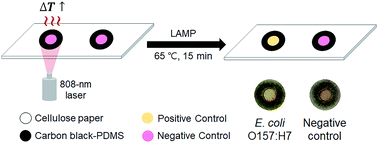A carbon-black-embedded poly(dimethylsiloxane)-paper hybrid device for energy-efficient nucleic-acid amplification in point-of-care testing†
Abstract
A paper-based device patterned with a carbon-black–poly(dimethylsiloxane) (PDMS) mixture is developed as a heating platform for nucleic-acid amplification tests. The photothermal effect of carbon black under 808 nm laser irradiation is used to conduct loop-mediated isothermal amplification (LAMP) to detect Escherichia coli (E. coli) O157:H7, a foodborne pathogen. We characterize the heat generation of carbon black by changing its concentration and the hardness of PDMS. Then, we optimize the minimum laser power required to perform LAMP. The proposed paper-based device requires less than 15 min to perform LAMP, and the result can be confirmed based on the color change observed by the naked eye. The rfbE gene of E. coli O157:H7 is specifically amplified, with a detection limit of 102 CFU mL−1. Amplification is also performed by using a laboratory-made laser-diode device, which consumes only 2 W h during its operation. The low cost, disposability, and easy fabrication of the paper-based device make it a powerful tool for point-of-care testing.

- This article is part of the themed collection: Analytical Methods HOT Articles 2022


 Please wait while we load your content...
Please wait while we load your content...